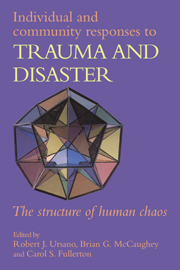Preface
Published online by Cambridge University Press: 13 October 2009
Summary
Traumas and disasters throw lives into chaos and fill individuals with the terror of the unexpected and the fear of loss, injury and death. Trauma is always a catalyst for change and adjustment; for some it also becomes a life long wound. A surprisingly high number of people are exposed to traumatic events each year. The effects of such events extend well beyond the direct victims to include their families, their communities, and those who try to help. All become part of the trauma and disaster community.
Much can be learned from these groups to better understand the human experience of trauma and to help those who are its victims. These are the goals of this volume. This book spans a wide array of traumas and disasters – from technological and natural disasters to the manmade disaster of war. There are many unique aspects of these various disasters, but also, frequently unnoticed common threads. All traumas and disasters stir terror; often they include exposure to death and the experience of physical injury. Fears of contamination, loss of home and the resulting relocation can further complicate recovery. Manmade and natural disasters differ in the degree to which they are felt to be preventable and controllable. When one asks who are the victims of trauma, there are no excluded groups. The victims of trauma span all ages and include groups and communities which may be far distant from an immediate disaster site.
- Type
- Chapter
- Information
- Individual and Community Responses to Trauma and DisasterThe Structure of Human Chaos, pp. xv - xviPublisher: Cambridge University PressPrint publication year: 1994

